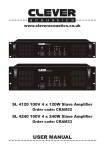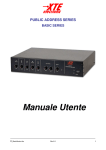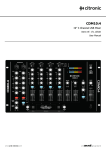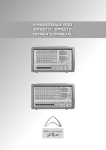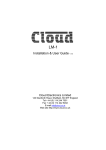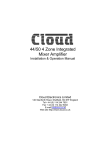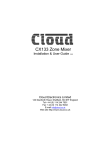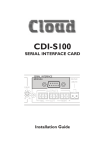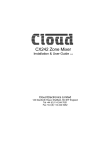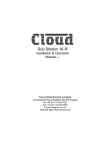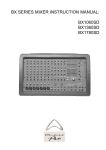Download Cloud Matrix 4 User guide
Transcript
Matrix 4 Installation & User Guide V 6.0 Cloud Electronics Limited 140 Staniforth Road, Sheffield, S9 3HF England Tel +44 (0) 114 244 7051 Fax +44 (0) 114 242 5462 Matrix 4 INSTALLATION AND OPERATION MANUAL 1 Matrix 4 Mixer Installation and operation manual Contents Section Page 1 Safety Notes...............................................................................2 2 General ......................................................................................2 3 Schematic Diagram ....................................................................2 4 Installation ..................................................................................2 5 Microphone inputs......................................................................2 6 Microphone Sensitivity ...............................................................3 7 Microphone Equalisation ............................................................4 8 High Pass Filter..........................................................................4 9 Microphone Level Controls.........................................................5 10 Microphone Routing Switches....................................................5 11 Master Microphone Level Controls.............................................5 12 Microphone Priority ....................................................................5 13 CPM-4 Paging Microphone ........................................................5 14 Paging Microphone Channel ......................................................6 15 Paging Microphone Input Gain...................................................6 16 Paging Microphone Controls ......................................................7 17 Music Inputs ...............................................................................7 18 Selection and control of music signals .......................................7 19 Outputs.......................................................................................7 20 EMC Considerations ..................................................................7 21 Technical Specifications.............................................................7 22 General Specifications ...............................................................8 Safety considerations and information .......................................8 16/12/02 V6.0 2 1 Matrix 4 INSTALLATION AND OPERATION MANUAL Safety Notes • • • • • Do not expose the unit to water or moisture. Do not expose the unit to naked flames. Do not block or restrict any air vent. Do not operate the unit in ambient temperatures above 35oC. Do not perform any internal adjustments unless you are qualified to do so and fully understand the hazards associated with mains operated equipment. • The unit has no user serviceable parts. Refer any servicing to qualified service personnel. • If the moulded plug is cut off the lead for any reason, the discarded plug is a potential hazard and should be disposed of in a responsible manner. For more detailed information refer to Safety Considerations & Information on page 8. 2 General The Cloud Matrix 4 is a versatile four-zone mixer. The unit has applications where four microphones a paging microphone and two line level music signals are required to feed up to four separate areas with full user control of the signal routing. The CPM-4 four-zone paging microphone is available as an accessory to the Matrix 4 (See section 13 for more details). The front panel mounted signal routing and level controls have been kept to a minimum, resulting in a logical layout easily understood by unskilled staff. 3 Schematic Diagram 4 Installation The Cloud Matrix 4 Mixer can be left free standing on a flat surface or be mounted in a standard 19” equipment rack where it will occupy three units of rack space. The Matrix 4 Mixer is 160mm deep but a total depth of 235mm should be allowed to clear rear panel connectors. 5 Microphone Inputs Four microphone inputs are provided; each of the four microphone amplifiers is an electronically balanced, transformerless design configured for optimum low noise performance. The input impedance is greater than 2kΩ and is suitable for microphones in the 200Ω to 600Ω range. Inputs are via gold-plated 3-pin XLR type connectors with latch and these are positioned on the rear panel. 16/12/02 V6.0 Matrix 4 INSTALLATION AND OPERATION MANUAL 3 For balanced microphones, connect the cable screen to pin 1, the in-phase signal (+) to pin 2 and the reverse phase signal (-) to pin 3. For unbalanced microphones, connect a wire link from pin 1 to pin 3 inside the XLR type cable mounted plug; use pin 1 as ground (cable screen) and pin 2 as hot. Phantom power facilities are provided; any one of the four inputs can be configured to operate with 15V phantom power by positioning the relevant jumper as detailed below: Phantom Power Jumper Locations MIC 1 INPUT MIC 1 PHANTOM POWER MIC 2 PHANTOM POWER MIC 2 INPUT OFF MIC 3 INPUT ON MIC 3 PHANTOM POWER MIC 4 PHANTOM POWER MIC 4 INPUT PAGING MIC INPUT PAGING MIC PHANTOM POWER When setting the jumpers please ensure that you: • Remove the mains cable from the rear of the product before removing the top panel. • Only reassemble the unit using screws identical to the original parts. • Only use a microphone that requires phantom power. 6 Microphone Sensitivity The microphone amplifier has a fixed gain of 40dB with an additional post level control gain of 20dB. The total gain of 60dB is adequate for all speech applications and maintains a high overload margin, however, it is important to operate the unit with the mic level control positioned at or above the 12 o’clock position. If the microphone signal is derived from a line level device such as a radio microphone the input amplifier can be configured to operate with a gain of 0dB (+20dB overall gain); by configuring the relevant PCB mounted jumper. The Jumpers are marked as J1,J2,J3&J4 and are associated with the microphone inputs as follows: J1 = Mic Input 1 J2 = Mic Input 2 J3 = Mic Input 3 J4 = Mic Input 4 A diagram showing the location of J1,2,3&4 can be found on the following page. 16/12/02 V6.0 4 Matrix 4 INSTALLATION AND OPERATION MANUAL Location of Jumpers J1, 2, 3 & 4 J1 MIC 1 MIC 1 INPUT INPUT GAIN SETTINGS MICROPHONE INPUT 40dB GAIN MIC 2 INPUT J2 MIC 2 J3 MIC 3 MIC 3 INPUT LINE INPUT 0dB GAIN MIC 4 INPUT J4 MIC 4 When setting the jumpers please ensure that you: • Remove the mains cable from the rear of the product before removing the top panel. • Only reassemble the unit using screws identical to the original parts. 7 Microphone Equalisation Separate two-band equalisation is provided for the composite microphone signals of each and every zone, a removable tamperproof plate on the front panel protects these pre-set EQ controls. The characteristics of the equalisation are optimised for the tonal correction of speech signals and the HF (Treble) control provides ±10dB at 5kHz with the LF (Bass) control ±10dB at 100Hz. A flat frequency response is achieved with the adjustment slots in the horizontal plane. 8 High Pass Filter All microphone signals pass through a simple high pass filter; this reduces the effects of breath blasts and handling noise. When used with 100V line systems, additional filtering can be introduced by setting the relevant internal jumpers to the ‘IN’ position; these filters also control the response of the music signals. Jumper details follow: J6 is for Zone 1 J7 is for Zone 2 J8 is for Zone 3 J9 is for Zone 4 When setting the jumpers please ensure you: • Remove the mains cable from the rear of the product before removing the top panel. • Only reassemble the unit using screws identical to the original parts. 16/12/02 V6.0 Location of Jumpers J6, 7, 8 & 9 Matrix 4 INSTALLATION AND OPERATION MANUAL 9 5 Individual Microphone Level Controls Separate, front panel mounted level controls are provided for all 4 microphones. Use these controls to set the operating level of each individual microphone; settings will vary depending upon the conditions, however, for optimum performance, set the controls to a minimum setting of 12 o’clock. Self-adhesive labels are provided to identify the microphone channels; the labels can be affixed in the spaces provided on the front panel. 10 Microphone Routing Switches All 5 microphones have illuminated routing switches for all four zones; when a switch is depressed, the button illuminates and the respective mic signal will be routed to the particular zone. The graphical design of the front panel, together with the illuminated switches, clearly shows the signal routing at a glance. 11 Master Microphone Level Controls Each of the four zones has a master microphone level control. Once the individual mic channel level controls are set, use the respective master control to adjust the composite level for a particular zone. For the benefit of the operator, self-adhesive labels are provided to identify the four zones; the labels can be affixed in the spaces provided on the front panel. 12 Microphone Priority The paging microphone has priority over all microphone and music signals. When a paging announcement is detected on any of the four zones, all other microphone signals are fully muted and any music signal present will be reduced by 30dB. When the paging microphone is not in use, the detection of a microphone signal will trigger the priority circuitry and reduce the level of the music signal by 30dB. Mic over music priority can be defeated by configuring jumper J10 located on the small PCB mounted on the rear of the front panel PCB. 13 CPM-4 Paging Microphone The Cloud CPM-4 is a 4 Zone paging microphone compatible with the Matrix 4 Mixer. The microphone includes Zone Selection, Talk and call-all buttons, Pre-announcement two-tone chime, Internal chime sounder, ‘Busy’ LED, ‘First-come first-served’ broadcast option, Auto zone reset after announcement and Zone disable. Such an array of functions makes the CPM-4 very versatile. Up to five CPM-4 paging mics can be connected to one Matrix 4. When installing the CPM-4 we recommend the use of two cables: a two core screened cable for the balanced mic signal and a separate 8 core cable with overall screen for the power and logic signals. A male type 9-pin sub-D type connector is supplied with the Matrix 4 to terminate the 8 core cable. The 9 pin sub-D connector shell must be connected to the cable screen. The Matrix 4 can provide +15V power for one CPM-4 microphone only; additional microphones will require the optional plug-top power supply unit CPM-PSU. Wiring a CPM-4 to a Matrix 4 16/12/02 V6.0 6 Matrix 4 INSTALLATION AND OPERATION MANUAL Multiple CPM-4 paging microphones can be connected to a Matrix 4 if wired as follows: Wiring Multiple CPM-4 Microphones to a Matrix 4 IMPORTANT NOTE: CONNECT +V POWER TO FIRST CPM-4 ONLY Details of the 9-pin D-Type connector terminations are below: Pin 1 Pin 3 Pin 5 Pin 7 Pin 9 14 Z3 logic signal Z1 logic signal Mic audio signal (+) +15V power Mic audio signal (-) Pin 2 Z2 logic signal Pin 4 Logic 0V Pin 6 Z4 logic signal Pin 8 Mic 0V (screen) Connector shell (earth) Paging Microphone Channel In addition to the provision to interface the CPM-4 four zone paging microphone, the paging mic channel is compatible with most microphones via the 3-pin XLR type connector. The Matrix 4 will operate with a standard paging mic with on/off button (signal muting type). When the 9 pin connector is not connected to a CPM-4, zone control reverts to the front panel routing switches. Phantom power is available (+15V) on the paging mic input and can be activated by configuring the adjacent PCB mounted jumper (See section 5 for full details). 15 Paging Microphone Input Gain The gain of the paging microphone amplifier is similar to the four standard mic inputs with PCB mounted jumper ‘J5’ allowing the selection of 40dB or 0dB gain. Gain compatibility with the Cloud CPM-4 paging microphone is provided by a third position on the jumper J5. When several CPM-4 mics are connected to one Matrix 4, the 40dB gain setting should be used. Jumper J5 Location and Settings PAGING MIC GAIN LINE INPUT - 0dB GAIN MIC INPUT - 40dB GAIN PAGING MIC INPUT CPM 4 INPUT - 30dB GAIN When setting the jumpers please ensure that you: • Remove the mains cable from the rear of the product before removing the top panel. • Only reassemble the unit using screws identical to the original parts. 16/12/02 V6.0 Matrix 4 INSTALLATION AND OPERATION MANUAL 16 7 Paging Microphone Controls The paging microphone input is controlled by the two-band equalisation adjacent to the input connector on the rear panel. The equalised signal is then routed to the four Zone Routing Switches positioned on the front panel. Use these switches to configure the operation of the paging mic in the desired zones. When one or more Cloud CPM-4 paging microphones are connected, the routing switches should be in the off position. Removal of the tamperproof panel reveals the pre-set paging mic level controls for each of the four zones. The paging mic signals are not affected by any other control or function and the signal is routed directly to the relevant zone output and amplifier stage with priority over all other signals. 17 Music inputs The Matrix 4 operates in mono but is fitted with two stereo line inputs via conventional RCA type phono sockets; the stereo signals are mixed to form a mono signal internally. The line inputs are suitable for most music sources such as compact disc players, tape players and receivers etc. All the inputs are unbalanced with an input impedance of 47kΩ. The gain control adjacent to the input sockets adjusts the input sensitivity from –12dBu (195mV) to +8dB (2.0V) and this should be set to provide the optimum signal level and a balance with the second music source, if used. 18 Selection and control of music signals Each of the four zones has a separate music level control and adjacent music source select switch allowing selection and control of either line 1 or line 2. In addition to this, each of the four zones has a set of two-band music equalisation controls on the front panel that are located behind the removable tamperproof panel. This arrangement allows the installer to optimise the response of the music signals on a zone-by-zone basis. The music treble control (HF) has a range of ±10dB at 10kHz and the music bass control (LF) operates with a range of ±10dB at 50Hz. A flat frequency response is achieved with the adjustment slot in the horizontal position. 19 Outputs The Matrix 4 Mixer is equipped with a line level balanced output for each zone via 3-pin male XLR type connectors. The nominal output level is 0dB (775mV) and the minimum load is 600 Ω 20 EMC Considerations The Cloud Matrix 4 fully conforms to the relevant electromagnetic compatibility (EMC) standards and is technically well behaved; you should experience no operational problems and under normal circumstances, no special precautions need to be taken. If the unit is used within close proximity to potential sources of HF disturbance such as high power communications transmitters, radar stations and the like, it is suggested that the microphone screen be connected to the metal shell of the XLR type connector and the input leads from music sources be kept as short as possible. 21 Technical Specifications Line inputs Frequency Response Distortion Sensitivity Input Gain Control Input Impedance Headroom Noise Equalisation 16/12/02 V6.0 20Hz-20kHz ±0.5dB <0.05% 20Hz -20kHz 195mV (-12dBu) to 2.0V (+8dBu) 20dB range 47kΩ >20dB -90dB 22Hz –22kHz HF: ±10dB/10kHz LF: ±10dB/50Hz 8 Matrix 4 INSTALLATION AND OPERATION MANUAL Microphone Inputs Frequency Response Distortion Gain Range Input Impedance Common mode rejection Headroom Noise Equalisation 100Hz / -3dB(filter), 20kHz ±0.5dB <0.05% 20Hz-20kHz -60dB >2kΩ (balanced) >70dB 1kHz >20dB -120dB EIN 22Hz-22kHz (150Ω) HF: ±10dB/5kHz LF: ±10dB/100Hz Outputs 775mV (0dBu) balanced (3 pin male XLR) 22 General Specifications Power input Fuse rating Fuse type Dimensions (cm) Weight (kg) 230V ±10% (internal adjustment for 115V) T100mA H for 230V supply T200mA H for 115V supply 20mm x 5mm class 250V 48.260 x 13.25(3U) x 15 deep (+ con) 4.10 net This product conforms to the following European EMC Standards: BS EN 55103-1:1997 BS EN 55103-2:1997 This product has been tested for use in commercial and light industrial environments. If the equipment is used in controlled EMC environments, the urban outdoors, heavy industrial environments or close to railways, transmitters, overhead power lines etc. the performance of the unit may be degraded. The product conforms to the following European electrical safety standard. BS EN 60065:1998 Safety Considerations and Information The unit must be earthed. Ensure that the mains power supply provides an effective earth connection using a three-wire termination. When the mains switch is in the off ‘O’ position the live and neutral conductors of the mains transformer are disconnected. CAUTION – Installation Do not expose the unit to water or moisture. Do not expose the unit to naked flames. Do not block or restrict any air vent. Do not operate the unit in ambient temperatures above 35oC. CAUTION - Mains Fuse Replace the mains fuse only with the same type and rating as marked on the rear panel. The fuse body size is 20mm x 5mm. CAUTION – Servicing The unit contains no user serviceable parts. Refer servicing to qualified service personnel. Do not perform servicing unless you are qualified to do so. Disconnect the power cable from the unit before removing the top panel and do not make any internal adjustments with the unit switched on. Only reassemble the unit using screws identical to the original parts. In the interest of continuing improvements Cloud Electronics Limited reserves the right to alter specifications without prior notice. Cloud Electronics Limited 140 Staniforth Road Sheffield S9 3HF England Telephone +44 (0) 114 244 7051 Fax +44 (0) 114 242 5462 E-mail: [email protected] 16/12/02 V6.0









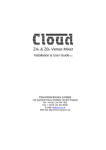
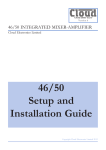
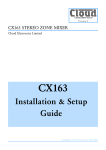


![CX122 User Guide [manual]](http://vs1.manualzilla.com/store/data/006893732_1-737783e5322cb6d4b2fce699c2324b84-150x150.png)
